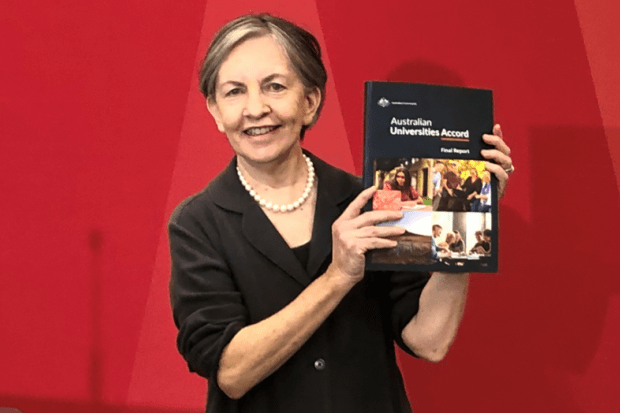While vice-chancellors have praised the ambition of the Australian Universities Accord’s final report, education minister Jason Clare said the government would not immediately commit to any of the report’s 47 recommendations.
“This is bigger than one budget,” Mr Clare told a launch ceremony in western Sydney. “This is a blueprint for higher education in this country for the next decade and beyond. We’ll respond to the report in the next few months. Over the…next few weeks, we’ll work on what we need to implement first to get us on the right path.”
Many of the recommendations would involve enormous cost. They include more than doubling the number of government-funded students, boosting subsidies for disadvantaged and regional students, increasing students’ living allowances, paying students on mandatory practicums and bankrolling fee-free preparatory courses.
On the research front, the panel recommended an increase in competitive grants for fundamental research and a massive boost in funding for research overheads, while also advocating coordinated efforts to raise overall research and development spending. Other big-ticket items include a new fund to incentivise impactful research and a future fund – bankrolled by both government and universities – to finance university infrastructure and student accommodation.
Mr Clare signalled backing for some of the less expensive recommendations, including the proposal for a tertiary education commission (TEC). “Sometimes you get a report like this and you kick things off, and then there’s a change of government or…minister and the report gathers dust on the shelf. We’ve got to drive reform over the long term and a tertiary education commission strikes me as a key part of that.”
While he would not be drawn on which recommendations might be easier to implement than others, he indicated support for the preparatory course proposal, highlighting Newcastle’s 50-year record of providing enabling programmes at no cost. “One in five people with a university degree out of the University of Newcastle started with one of those fee-free courses. It is the bridge that made that possible.”
During an earlier interview with the ABC, Mr Clare also signalled support for a proposal to ease pressure on low-income graduates by reorganising student loan repayments.
Australian National University policy expert Andrew Norton supported some of the report’s recommendations, including payments for practical placements and reforms to student living allowances. But he questioned the fundamental premise that lots more Australians needed higher education, saying the recommended 55 per cent target for degree attainment would require many more mediocre school performers to progress to university.
“They’ve got a higher chance of dropping out,” he said. “If they finish, they’ve got a reduced chance compared with other graduates of getting a well-paid job. Unless there can be a huge increase in prior academic achievement…it’s asking people to do something that is probably not in their own best interests.”
Professor Norton said there had been a “huge” surge in participation over the past two decades and the accord panel had not attempted to quantify how many “potential students” had missed out. “You can’t set a sensible target until you’ve identified whether…any significant number of people could benefit.”
But Innovative Research Universities executive director Paul Harris said the Productivity Commission had found there was still room in the Australian economy for a “big payoff” from increased public investment in education.
“The report has made a big set of recommendations designed to address equity and participation and better support students. We want to work with the government now to really crack on and start implementing some of this.”
Universities Australia (UA) chair David Lloyd said the “noble ambition” of increased participation – along with a strengthened research base – would yield a return on investment and productivity dividends. “The economic argument holds for me,” he said.
“The outcomes, if managed well, will be phenomenal. It has the potential to transform…tertiary education in Australia over a multigenerational timeline, and that’s its risk. It’s going to require unwavering commitment. The most important thing [in the report] is the TEC. We have to get that up and running immediately so that we have the runway to influence the delivery.”
UA chief executive Luke Sheehy said universities wanted an advisory committee – which would design the TEC, under the report’s recommendations – to be established quickly. He said the report’s reform vision required “20 years minimum” over “multiple, multiple budgets. But there are things [authorities] can do in the short term, including changes to the way they treat [student] debt.”
Shadow education minister Sarah Henderson acknowledged the review panel’s “hard work” but said the government’s response was disappointing. “While the report proposes a long-term blueprint for reform, the…government must provide the higher education sector with the certainty it deserves – not a pipe dream of promises.”
Register to continue
Why register?
- Registration is free and only takes a moment
- Once registered, you can read 3 articles a month
- Sign up for our newsletter
Subscribe
Or subscribe for unlimited access to:
- Unlimited access to news, views, insights & reviews
- Digital editions
- Digital access to THE’s university and college rankings analysis
Already registered or a current subscriber? Login








